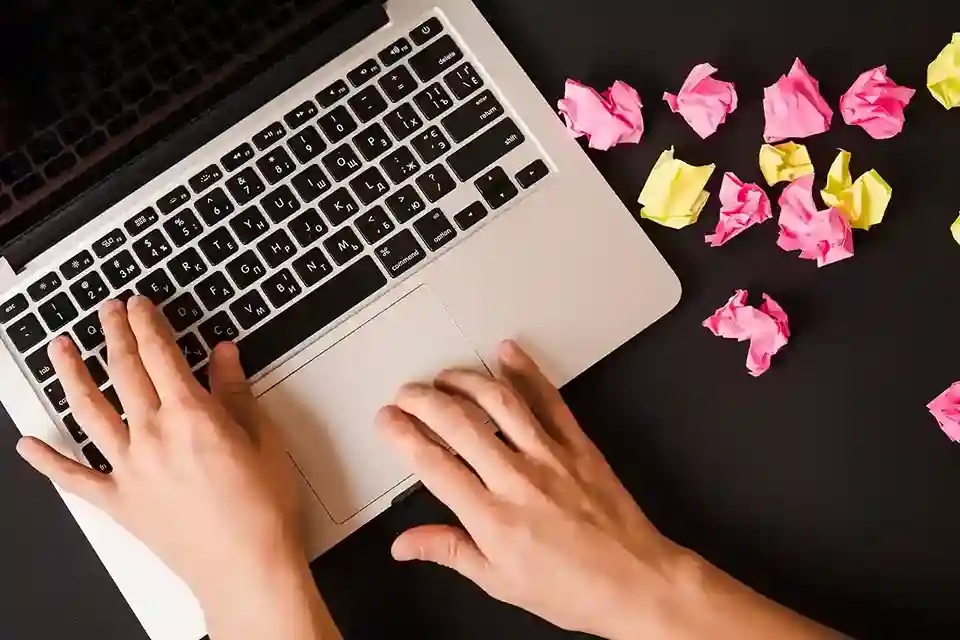Do you want to type faster? Many people make mistakes that slow them down without knowing it. These mistakes can make typing hard and slow. This article will help you find and fix the most common typing problems. By fixing these mistakes, you can type faster on your alphabet typer game and improve your typing speed.
Common typing mistakes slow down your touch Typing
Poor Posture Habits
When I teach typing classes, I notice many students slouching at their desks with elbows splayed out. This incorrect position makes it difficult to move your fingers vertically across the keyboard.
As someone who’s taught touch typing for years, I’ve seen how breaking wrists on the edge of the desk is a serious problem you should avoid. This bad habit leads to tired, sore joints over time and prevents your fingers from moving freely.
Before worrying about speed, fix how you sit! Your arms should be at right angles, with wrists slightly raised. This simple change helps your hands glide across the keys without strain.
Rushing Before Mastering Basics
Many people learning touch type think speed typing is the main goal. Yes, being proficient matters, but as a beginner, you need to go SUPER SLOW.
Going too fast results in tripping over your fingers and making lots of mistakes. You need time to think about which finger to move and how to make proper movements.
At Type IT, we use a foolproof system to help you remember key positions. But when you type too fast, your brain can’t process these patterns properly. I tell my students: “Slow is smooth, and smooth becomes fast!”
Start by practicing at half your normal speed. Focus on accuracy first, and speed will follow naturally as your muscle memory develops.

Finger Placement Problems
When I teach touch typing to beginners, I notice many have the same issue – they use the wrong fingers to press keys! It might seem like a trivial problem, but poor finger placement can seriously hold back your typing speed.
Many people find their speed stays static at around 40wpm because of this. In fact, about 80% of my students who come for help have this exact problem.
What does incorrect finger placement look like? Often I see:
- Middle fingers crossing over to reach keys that should be pressed with index fingers
- Using a dominant finger (usually the index) to press multiple keys that should be divided among different fingers
- Developing bad habits when you’ve learnt to type by yourself without proper guidance
These mistakes aren’t always obvious until someone watches how you type keys. That’s why checking your technique with an expert can solve problems that prevent you from typing fast.
I remember working with one student who couldn’t understand why her colleagues could type reports twice as quickly. After just 15 minutes of checking her technique, we discovered she was using only six fingers total instead of all ten! With proper finger placement training, her speed improved within days.
Regular practice with the correct finger positions will help you build muscle memory that allows your hands to flow naturally across the keyboard.
The Wandering Fingers Problem
When I first started teaching touch typing classes, I noticed many students struggling with this common problem. Letting your fingers wander from the home row will seriously affect both your speed and accuracy.
Here’s how to fix it:
- The home row is the foundation of successful touch typing
- Your fingers should always start from and keep returning to this position
- Feel those little bumps on the F and J keys? They help your fingers find the correct position without looking
- Touch typing is learnt through muscle memory
- When fingers drift to a different place, your keystrokes become inconsistent
- This leads to mistakes that slow you down
I’ve seen students improve dramatically once they focus on maintaining proper hand positioning. Your brain needs to build that muscle memory through consistent practice.
Don’t Rush Your Learning Journey
Many new typists make the mistake of rushing the learning process. I understand the hurry to learn touch type skills quickly, but there are no real shortcuts to mastery.
To become fully proficient:
- Understand that learning takes time
- Follow a structured approach
- Practice regularly – consistency beats intensity
- Recommend setting aside either 10 minutes every day or an hour per week
- Give yourself a few months to develop proper skills
- Becoming fully proficient typically requires around 20 hours of dedicated practice.
When you rush the process, some skills don’t get properly embedded in your memory. This causes problems that occur later – particularly low accuracy and reduced speed.
I’ve worked with hundreds of students who tried to take shortcuts, only to develop bad habits that were harder to break later. The ones who made steady progress without rushing ultimately typed faster and with fewer mistakes.
Not Learning All of the Keys
It’s very tempting to think you know enough to get by when you’re learning to type. I remember when I was first taking typing classes, I would often skip the trickier keys like the bottom row keys and punctuation. This led me to develop a hybrid style where I had to constantly look down at my keyboard for certain characters.
This poor habit completely undermines the purpose of learning touch typing! When you have to look at your keyboard, it will seriously impact your ability to type fast. I learned this the hard way and had to restrain myself later.
Guessing Where the Keys Are
Take your time and concentrate on making correct finger movements. Muscle memory is the foundation of good touch type skills. When you find yourself guessing where keys are, that’s a sign you need to slow down.
Instead of pushing forward with mistakes, try going back to basics. Drill each movement until it becomes automatic. This might feel boring, but it’s how I finally mastered the keyboard shortcuts after years of sloppy typing habits.
Use It or Lose It
Once you’ve learnt to touch typing, you must carry on using it. There’s a real danger of falling back into old habits if you don’t practice regularly.
Your initial typing speed might feel slower than your two finger speed at first. Don’t worry! The more you apply the skill, the faster your speed becomes. I had to persevere through this frustrating phase too. It’s important to keep practicing until the basic skill becomes second nature.
Practicing For Too Long
Learning any new skill like touch typing requires intense concentration. Your muscle memory develops better in short bursts rather than extended periods of practice.
I recommend just 20 minutes per day of focused practice. When I tried longer sessions, I would lose concentration and mistakes would creep in. Quality practice beats quantity every time!
Not Having Time
Finding time for learning to touch type can be challenging. It’s hard to fit in regular practice between work, school, and other responsibilities. This is especially true if you have a child trying to learn typing.
Sometimes, another hobby might need to be sacrificed in the short term to make room for typing practice. But remember, it’s an important skill that will save you countless hours in the future. Even my whole family adjusted our schedule to make typing practice a priority!
Conclusion
Correcting these frequent errors can significantly improve your typing speed and accuracy. Remember that good typing comes from practice and building the right habits. Prioritize accuracy at the beginning, and speed will develop on its own over time. Try our a to z typing test to see how much you improve!
By avoiding these mistakes and practicing regularly, you’ll see your typing speed increase. This will save you time and make working on your computer easier and more fun. Start practicing today and become a touch typing expert!

